Tuesday, 7 June 2011: The Mâconnais and the Beaujolais
Written 14 June 2011
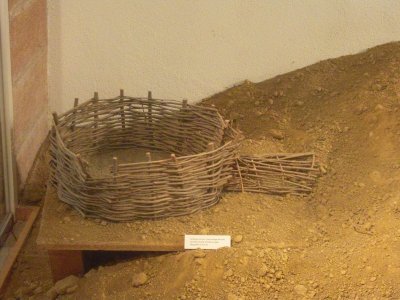
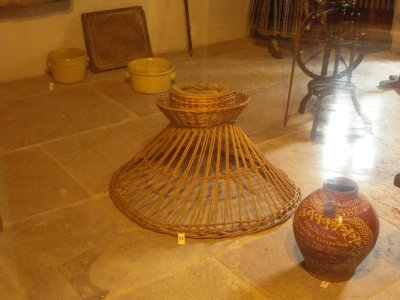 Tuesday morning, we walked down to the center of town again to visit the Musée des Ursulines and to see the famous Maison de Bois. The former is not, as the name might suggest, a museum of Ursuline nuns but a museum of local history and culture that is housed in an old Ursuline convent. There, we learned that Mâcon was founded in the 3rd century A.D. as a military outpost, and it stayed one until 1595, when Henri IV joined Bresse to France, at which Mâcon ceased to be a frontier town. Apparently not much about the town changed between the Middle Ages and the mid-18th century, after which the town expanded considerably.
Tuesday morning, we walked down to the center of town again to visit the Musée des Ursulines and to see the famous Maison de Bois. The former is not, as the name might suggest, a museum of Ursuline nuns but a museum of local history and culture that is housed in an old Ursuline convent. There, we learned that Mâcon was founded in the 3rd century A.D. as a military outpost, and it stayed one until 1595, when Henri IV joined Bresse to France, at which Mâcon ceased to be a frontier town. Apparently not much about the town changed between the Middle Ages and the mid-18th century, after which the town expanded considerably.
It included, in addition to the usual archeological findings ( stone tools from superior paleolithic; neolithic agricultural tools, arrowheads, and hunting gear; evidence of pre-Neanderthal, Neanderthal, and Cro-Magnon occupation), painting, reconstruction of the interiors of homes typical of the region's history, etc., excellent exhibits on a number of crafts. At the left is an armature, make of woven osier, for a pottery kiln. The armature would be covered with clay, and a separate domed lid would be constructed the same way. Pottery to be fired would be stacked in the rounded end of the chamber, a fire would be built in the other end, just by the mouth of tlhe little tunnel. The lid would be put on and sealed to the base, except for a small ventilation opening on the side away from the fire. Air would be drawn in through the tunnel, be heated by the fire, be drawn over the pottery, and escape through the ventilation hole. At the end, the lid would be broken and the pottery removed. A new lid would be made for each cycle, but the lower part could be used over and over.
The wicker contraption in the right-hand photo is a 19th century baby bouncer. The baby or toddler would be lowered in through the central opening, into a fabric seat, presumably so that it's feet could touch the floor so that it could scoot the whole thing around.
Another especially good display, on pottery making, included an antique foot-powered potter's wheel.
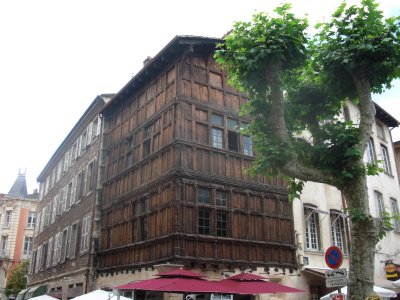
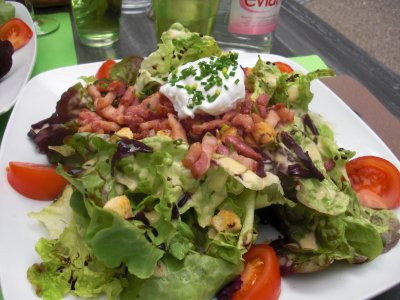 The "Maison de Bois" is the oldest house in Macon and, as is evident from the photo is wooden. The carved trim around the lower two levels consists of fanciful, cavorting characters, many unclothed, who alternate with carved animals, real and fanciful, and form a chain by holding their heads and tails. The Michelin guide gives a quotation from some early clergyman that I think I interpret correctly as meaning that good Christian passers by should avoid looking too directly at the carvings.
The "Maison de Bois" is the oldest house in Macon and, as is evident from the photo is wooden. The carved trim around the lower two levels consists of fanciful, cavorting characters, many unclothed, who alternate with carved animals, real and fanciful, and form a chain by holding their heads and tails. The Michelin guide gives a quotation from some early clergyman that I think I interpret correctly as meaning that good Christian passers by should avoid looking too directly at the carvings.
We had lunch at "The 88," out of the picture a few doors to the right, where we both had salade Lyonnaise again. We sat at table 38; the number was painted prominently on a rock that served as a table decoration. In addition to the usual stuff, these salads were laced with long crispy shreds of delicious marinated red cabbage.
In the afternoon, we took a long drive out through the Mâconnais and Beaujolais wine country. All the villages had mythic wine names: Morgon, Azé, Fleurie, Bagnols, St. Amour, Corcelles, Circié, Saint Véran, Pouilly, Solutré, Fuissé, Vinzelles, Moulin à Vent. David tells me that "Beaujolais" is the lowest-ranked Beaujolais wine. Next up the hierarchy is "Beaujolais Villages." At the top are the individual village names. The town square in Leynes displayed a sculpture in the shape of a giant spray of vine leaves.
We noticed that many vineyards in the Beaujolais region prune their vines into the "gobelet" shape (the shape of a stemmed wine glass, with a central stalk topped with a cup-shaped crown of branches—it lets the sun in the top and the grapes hang down on the outside of the "glass"), whereas the Mâconnais tended more toward the "baguette" shape, where a single stalk is trained sideways along a trellis.
Virtually every home yard and garden included a tree laden with dark, sweet cherries, and many included walnut trees full of small, unripe walnuts, as well. As usual, the grapes were always planted on the hillsides; the flatter areas on tops of hills were planted in grain.
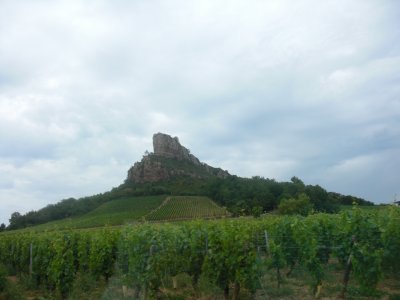
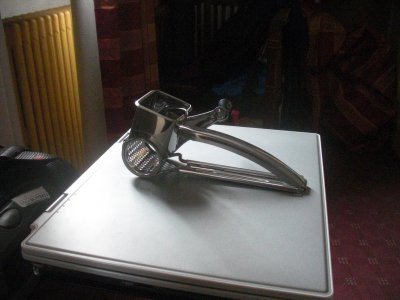 A major landmark of the area is the Rocher de Solutré, shown at the left here. From the side, it's sort of Gibraltar-shaped, but viewed edge on it's quite narrow, looking almost like a vertical column. You can follow a footpath to the top if you are so inclined, but we were not.
A major landmark of the area is the Rocher de Solutré, shown at the left here. From the side, it's sort of Gibraltar-shaped, but viewed edge on it's quite narrow, looking almost like a vertical column. You can follow a footpath to the top if you are so inclined, but we were not.
Back in Macon, while David napped, I went out with the dual intention of purchasing this handy stainless-steel grater, which I had seen in the shop's window, and visiting Old St. Vincent's church, of which only the narthex and two towers remain.
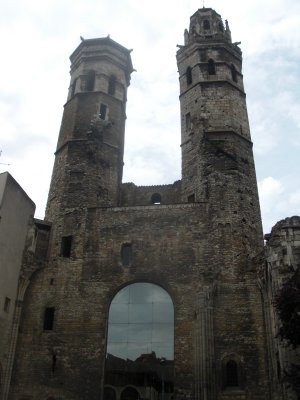
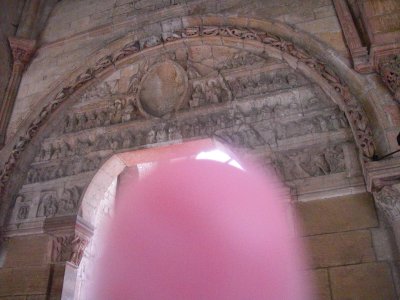 Buying the grater was easy; it was on special for 10 euros. It's primarily intended for cheese, but the shopkeeper says it can be used for parsley as well; I'll have to try that. I was delighted to find a metal one. All the ones in Tallahassee I can find are plastic (except for the blades), and their handles crack after a few months of use. I expected this one to be of tinned steel and therefore good only until the tin worn through and it rusted, but it proved to be stainless steel—it can even go in the dishwasher!
Buying the grater was easy; it was on special for 10 euros. It's primarily intended for cheese, but the shopkeeper says it can be used for parsley as well; I'll have to try that. I was delighted to find a metal one. All the ones in Tallahassee I can find are plastic (except for the blades), and their handles crack after a few months of use. I expected this one to be of tinned steel and therefore good only until the tin worn through and it rusted, but it proved to be stainless steel—it can even go in the dishwasher!
Visiting Old St. Vincent (11th century), just a block or two away, was also easy; it's free, and its museum is only a single room, housed in the narthex and consisting mainly of stone fragments from the missing parts of the building and reproductions of drawings and engravings showing parts of the church's original polychrome decor (lots of gruesome judgement day paintings of devils devouring lost souls). As I photographed the two mismatched towers, I was standing where the nave of the complete church was—the towers flanked the entrance to the nave, now filled with the reflective glass panels you see. Not so easy was photographing the most interesting part of the ruins, the carved archway over that entrance, which would have faced the people entering the church. Light was streaming in through the glass, causing hopeless photo flares. So the pink object in the photo is the end of my left index finger, which I positioned carefully in front of the camera to block the opening. Not elegant, but it got the flare out of the photo.
For dinner, we went to Restaurant Pierre, on one of the downtown pedestrian streets. The amuse-bouche was a small hot soup of cocos (small, fresh white beans) with whole beans and mushroom bits in the bottom; a small grilled salmon sandwich; and a tall glass with fig jam in the bottom and a mouse of foie grass on top, garnished with red onion sprouts.
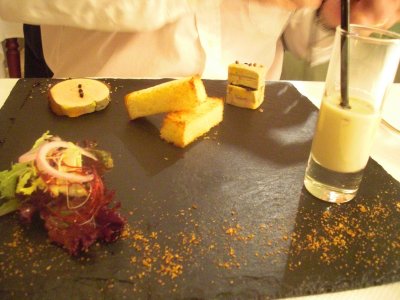
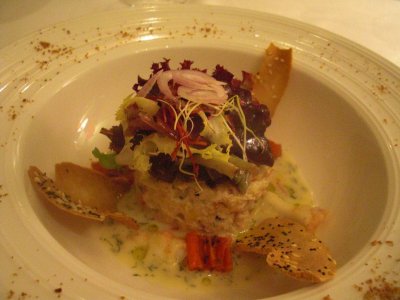 First course, David: Foie gras three ways, all cold: a round slice from a traditional preparation, two small squares sandwiched with something that David said was good but did not contribute to the conversation, and a "milkshake."
First course, David: Foie gras three ways, all cold: a round slice from a traditional preparation, two small squares sandwiched with something that David said was good but did not contribute to the conversation, and a "milkshake."
First course, me: A timbale of crabmeat and langoustine salad with "confit" tomato in a creamy sauce, topped with a tuft of salad greens and accompanied by sesame-poppy crackers. Tasty.
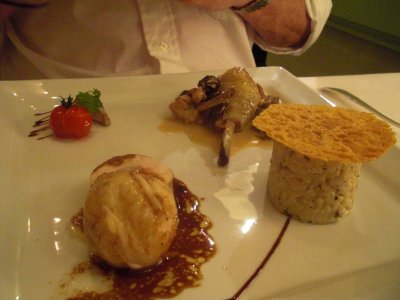
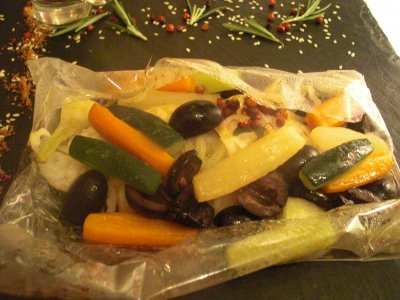 Main course, David: Bresse chicken (from the Miéral supplier) cooked two ways: the leg with cream and morels and the breast rolled into a round package and cooked with braised garlic and "strong-flavored" juice. Truffle risotto and Parmesan crisp.
Main course, David: Bresse chicken (from the Miéral supplier) cooked two ways: the leg with cream and morels and the breast rolled into a round package and cooked with braised garlic and "strong-flavored" juice. Truffle risotto and Parmesan crisp.
Main course, me: "Daurade royale" (Sparus aurata, gilthead seabream) cooked "en papillote" (traditionally, in a parchment-paper package, now made of high-tech heat-proof cellophane) with olives, fresh fennel, and "small vegetables of the moment" (artichokes, carrots, zucchini, onions, turnip ), with warm herb vinaigrette. All delicious, but I'm just a fan of Maillard browning reactions —I tend to think fish (and, for that matter, most foods) benefits from frying, sautéeing, roasting, or any other method that browns and crisps rather than just steaming.
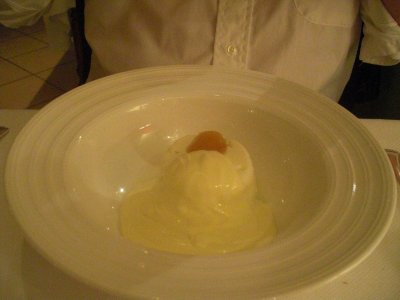
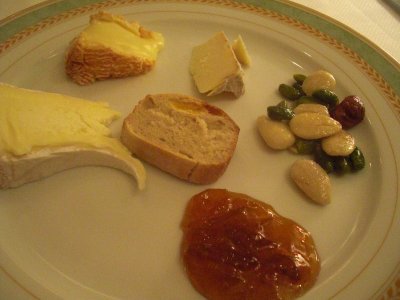 Cheese, David: His new favorite, fromage blanc with cream, here topped with one dried apricot.
Cheese, David: His new favorite, fromage blanc with cream, here topped with one dried apricot.
Cheese, me: Brillat-Savarin (the large white wedge), an atypically cohesive époisse (with the orange rind), and a small dry chèvre of some sort, accompanied by a small slice of fruit bread, some mixed nuts (almonds, pistachios, hazelnuts) in a light, salty glaze, and apricot jam. Excellent.
Please don't get the impression, because I tend to choose similar cheeses over and over, that the cheese trays of the region lack diversity. I just choose my favorities from among a much wider array.
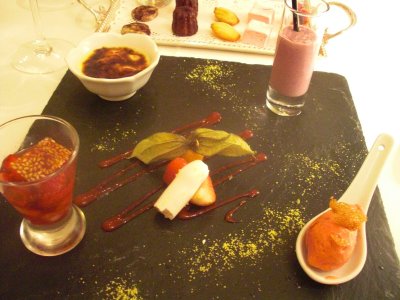
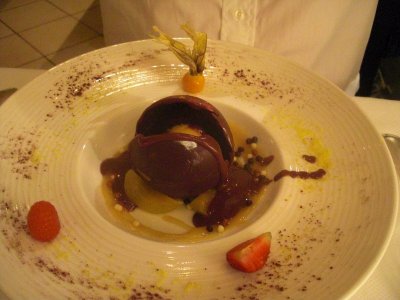 Dessert, me: "Declension" of red fruits: a little crême brulée with raspberries in it, a strawberry milkshake, berries in balsamic syrup, and red-fruit sorbet. In the center, pieces of fresh fruits and a piece of crisp, white meringue. Mignardises in the background: pink marshmallows, minimadeleines, minicannelés, little fruit cookies.
Dessert, me: "Declension" of red fruits: a little crême brulée with raspberries in it, a strawberry milkshake, berries in balsamic syrup, and red-fruit sorbet. In the center, pieces of fresh fruits and a piece of crisp, white meringue. Mignardises in the background: pink marshmallows, minimadeleines, minicannelés, little fruit cookies.
Dessert, David: David's favorite dessert, and perhaps favorite dish, of the trip—the "coque surprise chocolat aux abricots, crumble, mousse chocolat blanc, sorbet et sauce chaude lactée grand cru" (surprise chocolate shell with apricot, crumble, white chocolat mousse, and sorbet and hot milky sauce of fine chocolate). It came to the table as a shiny baseball-sized chocolate sphere resting on a few slices of fruit and the white chocolate mousse and garnished with a scattering of little brown and white chocolate beads. The server then took up a pitcher of steaming hot chocolate sauce, which she poured back and forth across the top, melting the sphere and causing it to crack open into two halves, which fell slowly away from each other, revealing a golf-ball-sized sphere of apricot sorbet resting on a bed of sugared cookie crumbs. David said it was so good it should be illegal!
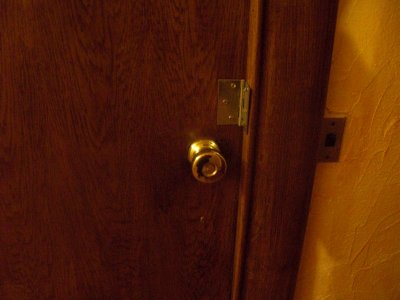 Here, as food for thought, is a photo of the door next to ours in the hotel at Macon.
Here, as food for thought, is a photo of the door next to ours in the hotel at Macon.
previous entry
List of Entries
next entry

 Tuesday morning, we walked down to the center of town again to visit the Musée des Ursulines and to see the famous Maison de Bois. The former is not, as the name might suggest, a museum of Ursuline nuns but a museum of local history and culture that is housed in an old Ursuline convent. There, we learned that Mâcon was founded in the 3rd century A.D. as a military outpost, and it stayed one until 1595, when Henri IV joined Bresse to France, at which Mâcon ceased to be a frontier town. Apparently not much about the town changed between the Middle Ages and the mid-18th century, after which the town expanded considerably.
Tuesday morning, we walked down to the center of town again to visit the Musée des Ursulines and to see the famous Maison de Bois. The former is not, as the name might suggest, a museum of Ursuline nuns but a museum of local history and culture that is housed in an old Ursuline convent. There, we learned that Mâcon was founded in the 3rd century A.D. as a military outpost, and it stayed one until 1595, when Henri IV joined Bresse to France, at which Mâcon ceased to be a frontier town. Apparently not much about the town changed between the Middle Ages and the mid-18th century, after which the town expanded considerably.
 The "Maison de Bois" is the oldest house in Macon and, as is evident from the photo is wooden. The carved trim around the lower two levels consists of fanciful, cavorting characters, many unclothed, who alternate with carved animals, real and fanciful, and form a chain by holding their heads and tails. The Michelin guide gives a quotation from some early clergyman that I think I interpret correctly as meaning that good Christian passers by should avoid looking too directly at the carvings.
The "Maison de Bois" is the oldest house in Macon and, as is evident from the photo is wooden. The carved trim around the lower two levels consists of fanciful, cavorting characters, many unclothed, who alternate with carved animals, real and fanciful, and form a chain by holding their heads and tails. The Michelin guide gives a quotation from some early clergyman that I think I interpret correctly as meaning that good Christian passers by should avoid looking too directly at the carvings.
 A major landmark of the area is the Rocher de Solutré, shown at the left here. From the side, it's sort of Gibraltar-shaped, but viewed edge on it's quite narrow, looking almost like a vertical column. You can follow a footpath to the top if you are so inclined, but we were not.
A major landmark of the area is the Rocher de Solutré, shown at the left here. From the side, it's sort of Gibraltar-shaped, but viewed edge on it's quite narrow, looking almost like a vertical column. You can follow a footpath to the top if you are so inclined, but we were not.
 Buying the grater was easy; it was on special for 10 euros. It's primarily intended for cheese, but the shopkeeper says it can be used for parsley as well; I'll have to try that. I was delighted to find a metal one. All the ones in Tallahassee I can find are plastic (except for the blades), and their handles crack after a few months of use. I expected this one to be of tinned steel and therefore good only until the tin worn through and it rusted, but it proved to be stainless steel—it can even go in the dishwasher!
Buying the grater was easy; it was on special for 10 euros. It's primarily intended for cheese, but the shopkeeper says it can be used for parsley as well; I'll have to try that. I was delighted to find a metal one. All the ones in Tallahassee I can find are plastic (except for the blades), and their handles crack after a few months of use. I expected this one to be of tinned steel and therefore good only until the tin worn through and it rusted, but it proved to be stainless steel—it can even go in the dishwasher!
 First course, David: Foie gras three ways, all cold: a round slice from a traditional preparation, two small squares sandwiched with something that David said was good but did not contribute to the conversation, and a "milkshake."
First course, David: Foie gras three ways, all cold: a round slice from a traditional preparation, two small squares sandwiched with something that David said was good but did not contribute to the conversation, and a "milkshake."
 Main course, David: Bresse chicken (from the Miéral supplier) cooked two ways: the leg with cream and morels and the breast rolled into a round package and cooked with braised garlic and "strong-flavored" juice. Truffle risotto and Parmesan crisp.
Main course, David: Bresse chicken (from the Miéral supplier) cooked two ways: the leg with cream and morels and the breast rolled into a round package and cooked with braised garlic and "strong-flavored" juice. Truffle risotto and Parmesan crisp.
 Cheese, David: His new favorite, fromage blanc with cream, here topped with one dried apricot.
Cheese, David: His new favorite, fromage blanc with cream, here topped with one dried apricot.
 Dessert, me: "Declension" of red fruits: a little crême brulée with raspberries in it, a strawberry milkshake, berries in balsamic syrup, and red-fruit sorbet. In the center, pieces of fresh fruits and a piece of crisp, white meringue. Mignardises in the background: pink marshmallows, minimadeleines, minicannelés, little fruit cookies.
Dessert, me: "Declension" of red fruits: a little crême brulée with raspberries in it, a strawberry milkshake, berries in balsamic syrup, and red-fruit sorbet. In the center, pieces of fresh fruits and a piece of crisp, white meringue. Mignardises in the background: pink marshmallows, minimadeleines, minicannelés, little fruit cookies. Here, as food for thought, is a photo of the door next to ours in the hotel at Macon.
Here, as food for thought, is a photo of the door next to ours in the hotel at Macon.